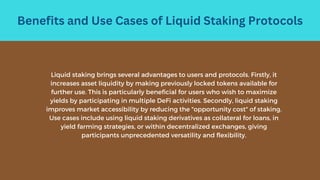Liquid Staking Development From Concept to Implementation.pdf
- 1. Liquid Staking Development: From Concept to Implementation www.blockchainx.tech
- 2. Liquid staking has emerged as a game-changing innovation within the decentralized finance (DeFi) and blockchain ecosystems. Unlike traditional staking, which requires users to lock up their assets, liquid staking allows participants to stake their tokens while retaining liquidity, making it possible to use those tokens in other DeFi applications. This added flexibility opens new avenues for users to earn additional returns and unlocks potential use cases for staked assets. As demand for Liquid staking protocol development services rises, developers and organizations are focusing on creating solutions that maximize capital efficiency while ensuring network security. In this article, we explore the journey from understanding the fundamentals of liquid staking to developing a full-fledged liquid staking protocol.
- 3. Understanding the Concept of Liquid Staking At its core, liquid staking separates staking rewards from asset immobility, overcoming a key limitation in traditional proof-of-stake (PoS) networks. Participants who stake tokens through liquid staking protocols receive a tokenized version of their staked assets, often referred to as staking derivatives. These derivatives can then be traded, borrowed, or used in DeFi applications, thereby enhancing the efficiency and utility of capital within the blockchain ecosystem. Developers and projects have recognized this as a promising way to optimize asset utilization while maintaining network security.
- 4. Benefits and Use Cases of Liquid Staking Protocols Liquid staking brings several advantages to users and protocols. Firstly, it increases asset liquidity by making previously locked tokens available for further use. This is particularly beneficial for users who wish to maximize yields by participating in multiple DeFi activities. Secondly, liquid staking improves market accessibility by reducing the "opportunity cost" of staking. Use cases include using liquid staking derivatives as collateral for loans, in yield farming strategies, or within decentralized exchanges, giving participants unprecedented versatility and flexibility.
- 5. Design Considerations for Liquid Staking Protocol Development To build a successful liquid staking protocol, developers need to carefully plan several design aspects. Tokenomics is crucial: staking derivatives should be properly incentivized to maintain price stability while rewarding users. Smart contracts must be secure and resilient, protecting against common attack vectors in the DeFi space, such as reentrancy attacks and flash loan exploits. Furthermore, compatibility with other DeFi applications is essential to maximize the utility and adoption of staking derivatives. Developers should also aim to integrate governance models that align with community interests and uphold protocol transparency.
- 6. Implementation Phases: From Blueprint to Production Planning and Research : This phase involves identifying market needs, analyzing existing solutions, and defining unique value propositions for your protocol. Developers should research industry standards, security best practices, and innovative approaches to deliver a superior solution. Protocol Design and Development : The design phase encompasses creating smart contract architecture, developing the staking and unstaking mechanics, and issuing staking derivatives. It is vital to conduct thorough testing to ensure code security and compatibility. Auditing and Security Assessment : Before deployment, protocols must undergo rigorous audits from reputable security firms. This includes smart contract auditing, penetration testing, and addressing identified vulnerabilities to ensure maximum security. Launch and Community Integration : A successful launch involves marketing, onboarding community members, and providing comprehensivedocumentation and user support. Engaging with the community ensures adoption and continuous feedback for protocol improvement.
- 7. Future Outlook for Liquid Staking Protocols Liquid staking is still a rapidly evolving area within DeFi and has vast potential for growth. As more protocols adopt liquid staking and experiment with unique implementations, we can expect innovations in governance, composability, and risk management. Collaborations with other DeFi sectors will continue to strengthen the ecosystem and offer users ever more sophisticated tools for leveraging their staked assets.
- 8. Conclusion From concept to implementation, building a liquid staking protocol is a challenging yet rewarding endeavor. It holds the promise of reshaping how assets are utilized and staked in blockchain networks, bringing flexibility, security, and new possibilities to users and developers alike. As the demand for Liquid staking protocol development solutions continues to grow, innovative protocols and services will further enhance capital efficiency and drive adoption across the DeFi landscape.









